
The Tolopka's
Meet the Olympics
Minor Sports Day: Monday, 18 September 2000
There are many advantages to attending the Olympics in person rather than
watching TV coverage back in the U.S. Among them:
-
Watching the events live rather than tape-delayed by six thousand hours;
-
Watching the events almost live on the ubiquitous TVs even if you
don't attend a specific event;
-
Discovering that countries other than the USA and Their Hated Archrivals
in Some Particular Sport compete in the Games;
-
Seeing what Olympic sports look like when performed by someone who's very
very good but not necessarily #1 or #2 in the world;
-
Fewer, less insipid commercials during TV coverage;
-
Spending the majority of your time watching actual sport rather than getting
Up Close and Personal with a human interest story.
But one of the best advantages is that you can watch events that you never
get to see on US TV coverage. Preferably live and in person.
| Since we were again plenty early in arriving at the venue, we had plenty
of time to wander around and check out the goings-on. Among other
things, we attempted the widely-practiced diversion of Taking Humorous
Pictures Involving the Olympic Flame; our effort is shown at right.
(Note the fellow at back left playing the same game!) |
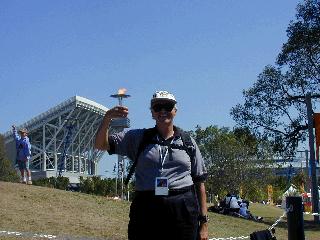 |
.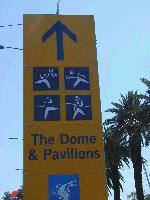 |
Our morning tickets were for badminton, so we followed the pictographs
to the Pavilions. The sports pictographs are an interesting thing;
they look pretty cool, but they're not all that helpful for actually finding
a sport since they tend to (a) look very much alike from a distance, and
(b) be largely incomprehensible with random appendages and mysterious equipment
attached to a little person. |
| The badminton venue had three courts, generally with matches
in progress on all three simultaneously. We arrived in time to see
the end of some women's singles matches, but also saw men's singles and
mixed doubles before the session ended. World-class badminton is
a game of interesting contrasts, constantly changing from furiously hard
smashes to delicate finesse shots at the net. At right, a top player
from Indonesia leaps to fire a high-speed shuttlecock back at his Chinese
opponent. |
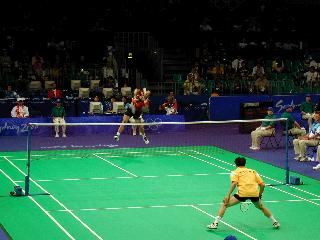 |
Shuttlecocks tend not to last very long under this kind of abuse.
These aren't your backyard plastic wonders, but carefully crafted from
goose feathers for proper flight. Either player can ask for a new
shuttlecock when he determines that the current one has outlived its usefulness.
Of course, you can't just get a new one, you first have to engage in a
little ritual by showing the wounded bird to your opponent and then petitioning
the umpire for a change. At this point, the second umpire pulls the
next shuttlecock out of the tube that he keeps and play resumes.
Women's matches, which are shorter and less power-laden, use only a dozen
or so shuttlecocks per match, while men's matches use anywhere from 20
to 40. At three bucks a pop, badminton at this level ain't cheap!
To underscore the point, "shuttlecocks used" is one of the official statistics
displayed at the end of each match. We never found out exactly why
-- apparently it's just a matter of prurient interest!
Despite the high-speed action, we actually had trouble staying awake
for a while. The day was warm, and the air inside the Pavilion was
hot and stuffy -- practically no ventilation at all, which was tending
to put us to sleep. Then Ken has the Aha! moment: Of course
there's no ventilation in the arena since it would play hob with the flight
of the shuttles! Fortunately, a couple of good matches started up
that reclaimed our attention.
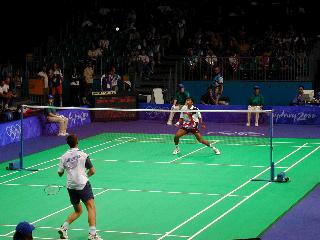 |
One of the more interesting singles matches of the afternoon featured
#2 seed Gopichand (India, far court) against Druzchenko (Ukraine, near
court). Gopichand just creamed him in the first game:
15-3, but it didn't even look that close. Near the end of the first
game, Druzchenko engaged in a heated discussion with the umpire about shuttlecocks.
Nearly as we can tell, he was complaining that these 'cocks flew a few
inches too far on average. A new tube was fetched, each player whapped
several shots from end line to end line, and eventually everyone was satisfied
enough to finish the game. We don't know whether those few inches
were crucial or whether the break just disturbed Gopichand's rhythm, but
the second game was a complete turnaround, with Druzchenko taking a 13-1
lead before Gopichand came back to make it close. The deciding game
was nip and tuck to around 9-9, but then Druzchenko lost his touch while
Gopichand rediscovered his and closed out the match. |
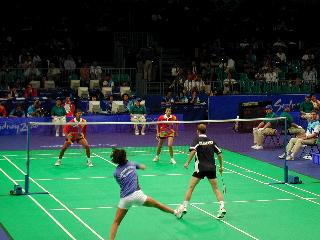 |
If we thought singles was fast and colorful (there were some great
national jerseys, as you can see in these photos), then the mixed doubles
was even better. With a second player perched near the net to pick
up drop shots, pounce on too-short lobs, and intercept smashes, the pace
of the game reminded us of gerbils. Here, the Danish team (near court)
managed to outdo their Indonesian opponents in another exciting 3-game
match. (This is yet another thing you discover by being here -- who'dve
thought Denmark was a hotbed of badminton?) |
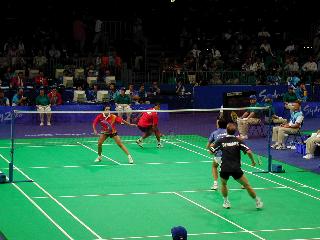 |
| After the badminton session ended, we had time to kill before our evening
tickets kicked in, so we went shopping in the Olympic Superstore located
in the Park. Anything you can imagine that might have an Olympic
logo (and probably some things you can't) is for sale in this store; it's
simply a huge place. We took turns visiting the store with
Ken and Sharon since there were two ways to get in: (1) Stand in a looooooong
queue that got you a canvas bag in which your could lock your backpack,
etc., until you came out the other side of the store, or (2) carry nothing
except your wallet and walk right in. Choice #2 seemed by far the
wiser, so we took turns leaving couples in charge of the daypacks.
Naturally, purchases could be charged only with Visa, the Official Credit
Card of the Sydney Olympics. For what I assume were backward-compatibility
reasons, they were also willing to accept cash <grin>. |
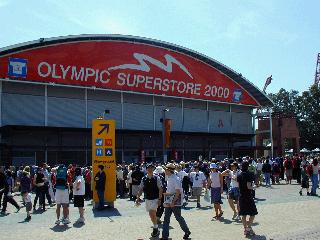 |
Despite its charms, shopping is not enough to hold body and soul together
forever, so we next went in search of dinner. Food booths are plentiful
throughout the venue, and despite complaints from the locals ("$3.80 for
a meat pie?! Those should be a dollar eighty-five!") it doesn't seem
particularly expensive, especially once you figure in the generous exchange
rate currently in effect. However, "plentiful" doesn't exactly equate
to "tasty". Mostly, it suffers from the problems of mass-scale cooking
everywhere: uneven quality and doneness, bland seasoning, a certain
uniformity of texture and taste no matter what you order, and potatoes
with everything. Having suffered through several of these meals by
now, we found ourselves doing something I would never have dreamed possible:
Heading for McDonald's Central for a high-class meal. In the country
of the blind, the one-eyed man is king ....
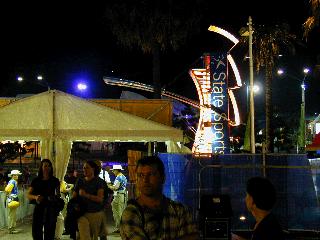 |
After a sumptuous Big Mac or two, it was now time to head for the State
Sports Centre at the south end of the Park for table tennis, which pictographically
looks a lot like tennis or badminton with the hint of an itty-bitty net. |
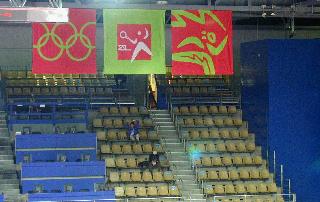 |
| Once again, the parade of the athletes opened the session, after which
officials got busy doing things like carefully measuring the height of
the net with itty-bitty rulers. Despite the fact that it makes perfect
sense, the umpire perched above the table in his/her chair and the presence
of a second umpire seemed rather comical -- but oh, so civilized.
At least they didn't seem to think having linesmen on all the corners was
necessary! |
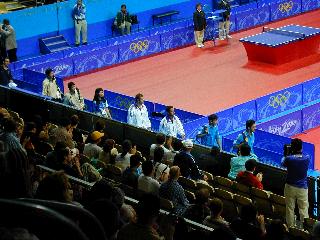 |
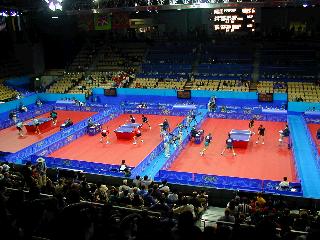 |
Then after brief warm-ups, they set to in earnest. There were
four tables in the arena all going at once, each table overwhelmed by four
players going gangbusters. If you've never seen or played real table
tennis doubles, you may not realize how the game is played -- players must
take turns returning shots! As you can imagine, this ensures a great
deal of frenetic motion as players set up for the next shot and get out
of the way of their partners. If badminton looked like gerbils, this
looked like gerbils on Benzedrine. Most of the rallies were relatively
brief, but every now and then you'd see smash after smash being successfully
returned from 5 meters behind the table -- astonishing reactions and control. |
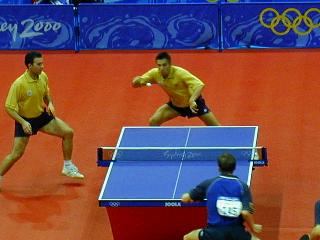 |
Once again, this proved to be a highly international competition, with
teams hailing from every continent. (Okay, no Antarctic participants
-- sue me!) Nigeria fielded two teams, the Australians were heavily
cheered ("Oi! Oi! Oi!") in their match against Hong Kong, although it wasn't
enough to pull them through. Action at left shows Yugoslavia (yellow)
v. Germany (blue); at right is Chile (red) v. Japan (blue). |
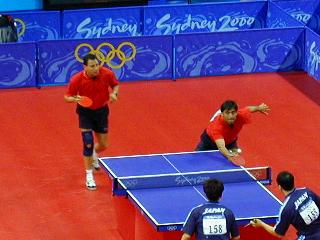 |
| Before we left home, we packed the little American flags that we use
when we march in Fourth of July parades. Tonight they came in handy
as we cheered for the American team (red) that was playing against Belarus
(blue). Unfortunately, we had even less luck than the Aussies, and
our boys went down without much of a fight. Time to pack the flags
away for another day! |
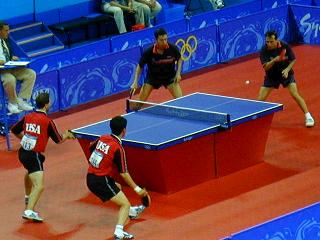 |














